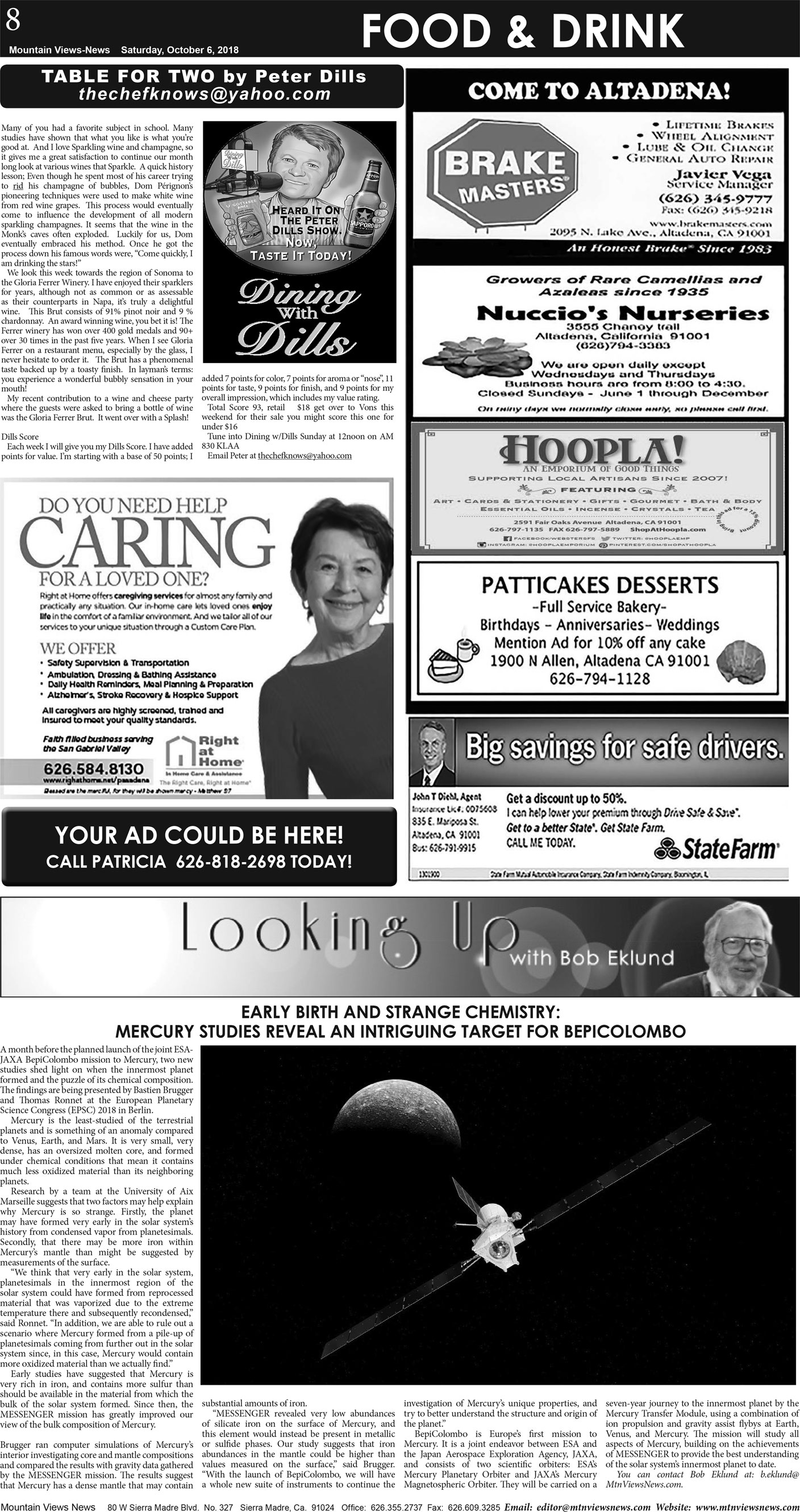| Food, Drink & More | ||||||||||||||||||||
| Mountain Views News, Sierra Madre Edition [Pasadena] Saturday, October 6, 2018 | ||||||||||||||||||||
| ||||||||||||||||||||
|
8 FOOD & DRINK Mountain Views-News Saturday, October 6, 2018 TABLE FOR TWO by Peter Dills thechefknows@yahoo.com Many of you had a favorite subject in school. Many studies have shown that what you like is what you’re good at. And I love Sparkling wine and champagne, so it gives me a great satisfaction to continue our month long look at various wines that Sparkle. A quick history lesson; Even though he spent most of his career trying to rid his champagne of bubbles, Dom Pérignon’s pioneering techniques were used to make white wine from red wine grapes. This process would eventually come to influence the development of all modern sparkling champagnes. It seems that the wine in the Monk’s caves often exploded. Luckily for us, Dom eventually embraced his method. Once he got the process down his famous words were, “Come quickly, I am drinking the stars!” We look this week towards the region of Sonoma to the Gloria Ferrer Winery. I have enjoyed their sparklers for years, although not as common or as assessable as their counterparts in Napa, it’s truly a delightful wine. This Brut consists of 91% pinot noir and 9 % chardonnay. An award winning wine, you bet it is! The Ferrer winery has won over 400 gold medals and 90+ over 30 times in the past five years. When I see Gloria Ferrer on a restaurant menu, especially by the glass, I never hesitate to order it. The Brut has a phenomenal taste backed up by a toasty finish. In layman’s terms: you experience a wonderful bubbly sensation in your mouth! My recent contribution to a wine and cheese party where the guests were asked to bring a bottle of wine was the Gloria Ferrer Brut. It went over with a Splash! Dills Score Each week I will give you my Dills Score. I have added points for value. I’m starting with a base of 50 points; I added 7 points for color, 7 points for aroma or “nose”, 11 points for taste, 9 points for finish, and 9 points for my overall impression, which includes my value rating. Total Score 93, retail $ 18 get over to Vons this weekend for their sale you might score this one for under $16 Tune into Dining w/Dills Sunday at 12noon on AM 830 KLAA Email Peter at thechefknows@yahoo.com EARLY BIRTH AND STRANGE CHEMISTRY: MERCURY STUDIES REVEAL AN INTRIGUING TARGET FOR BEPICOLOMBO A month before the planned launch of the joint ESA- JAXA BepiColombo mission to Mercury, two new studies shed light on when the innermost planet formed and the puzzle of its chemical composition. The findings are being presented by Bastien Brugger and Thomas Ronnet at the European Planetary Science Congress (EPSC) 2018 in Berlin. Mercury is the least-studied of the terrestrial planets and is something of an anomaly compared to Venus, Earth, and Mars. It is very small, very dense, has an oversized molten core, and formed under chemical conditions that mean it contains much less oxidized material than its neighboring planets. Research by a team at the University of Aix Marseille suggests that two factors may help explain why Mercury is so strange. Firstly, the planet may have formed very early in the solar system’s history from condensed vapor from planetesimals. Secondly, that there may be more iron within Mercury’s mantle than might be suggested by measurements of the surface. “We think that very early in the solar system, planetesimals in the innermost region of the solar system could have formed from reprocessed material that was vaporized due to the extreme temperature there and subsequently recondensed,” said Ronnet. “In addition, we are able to rule out a scenario where Mercury formed from a pile-up of planetesimals coming from further out in the solar system since, in this case, Mercury would contain more oxidized material than we actually find.” Early studies have suggested that Mercury is very rich in iron, and contains more sulfur than should be available in the material from which the bulk of the solar system formed. Since then, the MESSENGER mission has greatly improved our view of the bulk composition of Mercury. Brugger ran computer simulations of Mercury’s interior investigating core and mantle compositions and compared the results with gravity data gathered by the MESSENGER mission. The results suggest that Mercury has a dense mantle that may contain substantial amounts of iron. “MESSENGER revealed very low abundances of silicate iron on the surface of Mercury, and this element would instead be present in metallic or sulfide phases. Our study suggests that iron abundances in the mantle could be higher than values measured on the surface,” said Brugger. “With the launch of BepiColombo, we will have a whole new suite of instruments to continue the investigation of Mercury’s unique properties, and try to better understand the structure and origin of the planet.” BepiColombo is Europe’s first mission to Mercury. It is a joint endeavor between ESA and the Japan Aerospace Exploration Agency, JAXA, and consists of two scientific orbiters: ESA’s Mercury Planetary Orbiter and JAXA’s Mercury Magnetospheric Orbiter. They will be carried on a seven-year journey to the innermost planet by the Mercury Transfer Module, using a combination of ion propulsion and gravity assist flybys at Earth, Venus, and Mercury. The mission will study all aspects of Mercury, building on the achievements of MESSENGER to provide the best understanding of the solar system’s innermost planet to date. You can contact Bob Eklund at: b.eklund@ MtnViewsNews.com. Mountain Views News 80 W Sierra Madre Blvd. No. 327 Sierra Madre, Ca. 91024 Office: 626.355.2737 Fax: 626.609.3285 Email: editor@mtnviewsnews.com Website: www.mtnviewsnews.com | ||||||||||||||||||||



















